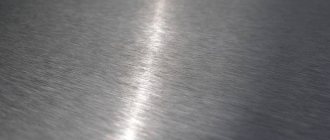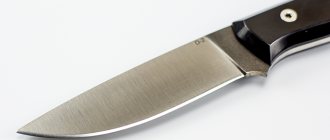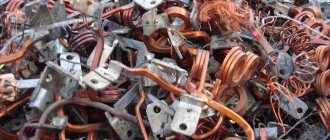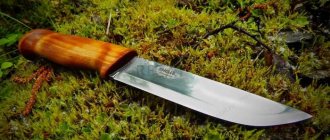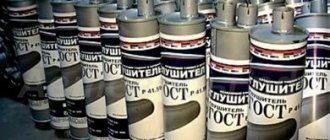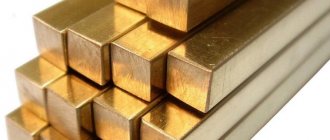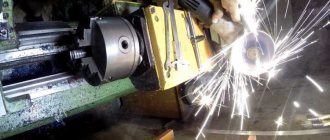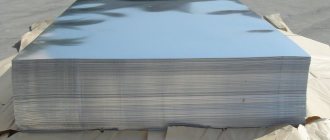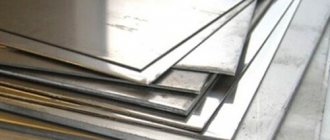Is stainless steel a non-ferrous metal or a ferrous one?
Very often, at scrap metal collection points, people get confused and do not know which metal is stainless steel - non-ferrous or ferrous. The composition of stainless steel can be different, depending on the brand, type and purpose.
So what is stainless steel? What metals does it belong to, ferrous or non-ferrous? This article from a construction magazine will examine the composition of stainless steel and its main differences from non-ferrous and ferrous metals.
Stainless steel composition
Stainless steel contains about 20% chromium, it also contains carbon, nickel, cobalt, manganese, sulfur, and, of course, iron. It is precisely because stainless steel contains both non-ferrous and ferrous metals that most often disagreements arise about its involvement in a specific group of metals.
Stainless steel indeed has unique characteristics in its own way. It is highly resistant to corrosion, even in very aggressive environments. There are nickel, chromium, and chromium-nickel types of stainless steel that are durable and resistant to mechanical damage.
Differences between ferrous and non-ferrous metals
Ferrous metals include iron and alloys based on it, steel, for example, or cast iron. All of them have high tensile strength and are widely used both in the manufacture of reinforced concrete structures, in the automotive industry, construction, etc.
Non-ferrous metals include copper, aluminum, nickel, zinc, tin and others. A distinctive feature of non-ferrous metals is their lower strength and higher cost than ferrous metals. In addition, the main difference between non-ferrous metal and ferrous metal is the absence of iron in its composition.
There is also a so-called class of precious metals, which, as you might have guessed, includes gold, silver, cobalt, chromium and other metals. Therefore, the main difference between ferrous and non-ferrous metals is the presence or absence of iron in their composition.
To check what kind of metal is in front of you, black or non-ferrous, you can use a very ordinary magnet. Just bring it to the metal, and if there is absolutely no attraction, then this means that this is non-ferrous metal.
Stainless steel is a non-ferrous or ferrous metal
As mentioned earlier, stainless steel contains both iron and non-ferrous metals. As a result of this, confusion actually arises, which stainless steel is a non-ferrous or ferrous metal?
Stainless steel is an alloy consisting of non-ferrous and ferrous metals. The almost equal content of iron and non-ferrous metals in the composition of stainless steel does not allow it to be classified as a specific metal, ferrous or non-ferrous.
If we talk about scrap metal collection points, then there they accept stainless steel as non-ferrous metal. This happens because stainless steel contains a large amount of nickel, chromium, and other non-ferrous metals. Therefore, it is more profitable to classify stainless steel scrap as non-ferrous metal than as ferrous scrap.
In addition to the composition, a significant difference can be seen in the prices of ferrous metal and stainless steel. As a rule, the cost of ferrous metal is calculated based on one ton, and for stainless steel, just one kilogram of scrap. As mentioned above, the cost of non-ferrous metals is always more expensive. Therefore, stainless steel costs about half as much as ferrous metal.
Source of the article: https://samastroyka.ru/nerzhaveyka.html
What metal is stainless steel?
Very often, when our clients are faced with the need to hand over stainless steel, they wonder: is stainless steel a non-ferrous metal or is it still ferrous? Stainless steel is a material whose composition varies and depends on its type, brand, and purpose. The alloy contains 12-20% chromium, but may also contain nickel, carbon, silicon, manganese, sulfur, phosphorus, cobalt, molybdenum. Disagreements regarding whether stainless steel is a non-ferrous or ferrous metal arise due to the fact that the composition contains both iron and various non-ferrous metals.
Before we tell you in detail what kind of metal stainless steel is, we draw your attention to the fact that the Metal-Snab company accepts stainless steel on favorable terms in Moscow and the Moscow region.
| Type of stainless steel | Price per kg, rub |
| Lumps of stainless steel scrap with nickel content from 9.3% to 11% (ns 10%) | 110 |
| Lumps of stainless steel scrap with nickel content from 9.00% to 9.2% (ns 9%) | 60 |
| Lumps of stainless steel scrap with nickel content from 8% to 9% (ns 8%) | 95 |
| Lumps of stainless steel scrap with nickel content from 7% to 8% (ns 7%) | 40 |
Brands, chemical composition and properties
Rolled carbon in the form of thin sheets is made from certain grades of alloy of ordinary quality: St1, St2sp, St2ps, St2kp, StZps, StZkp, StZsp, St4ps, St4kp, St4sp, Stbsp, Stbps. In this case, marking involves the use of paints of different colors.
Limits of mechanical parameters of black non-corrosive alloys:
- yield strength: from 196 to 400 N/sq. mm;
- temporary resistance: from 320 to 680 N/sq. mm;
- relative elongation: 12-33%;
- relative narrowing: 35-60%.
In the production of sheets for simple purposes, stainless steel 1 mm - 3.9 mm is used. In accordance with the standards of GOST 380-94, the mass fraction of the main components in the composition varies as follows:
- chromium – from 0.1 to 0.25;
- silicon – from 0.05 (St2kp) to 0.3 (St5Gps);
- manganese – from 0.25 (St0) to 0.8 (Stbps);
- carbon – from 0.06 (St1kp) to 0.49 (Stbsp).
Depending on the method by which stainless steel is produced , this percentage may vary. For example, in the scrap process, a mass fraction of Cu up to 0.4%, and Ni and Cr up to 0.35% is acceptable. However, GOST stipulates maximum deviations for rolled products, forgings, blanks and other products.
Differences between non-ferrous and ferrous metals
Ferrous metals are iron, as well as various iron-based alloys, such as cast iron or steel. They have high tensile strength and are widely used in construction. Ferrous metal products are used:
- in the automotive industry;
- for the manufacture of reinforced concrete structures;
- production of various pipes;
- performing reinforcement.
The easiest way to understand that a metal is black is to hold a magnet close to it. The attraction indicates the iron content in the composition.
Non-ferrous metals are less durable and more expensive. Their main and key difference from black ones is the absence of iron. They are malleable and versatile, these include:
- copper and nickel;
- aluminum and brass;
- zinc and tin.
There is also a class of precious non-ferrous metals - gold, silver, chrome, cobalt.
Thus, we can say that the main difference between non-ferrous and ferrous metal is the presence or absence of iron in the composition.
Types of precious metal scrap
This category includes:
- jewelry, put out of use for various reasons, and its fragments;
- elements of silver-zinc batteries, catalysts, chemical equipment and other devices containing precious metals;
- parts and elements of radio-electronic devices;
- some other products.
The procedure for receiving and storing precious metal scrap differs significantly from the usual due to the need to ensure its proper accounting and proper storage conditions.
Stainless steel is an alloy of ferrous and non-ferrous metals
So what is stainless steel? Is stainless steel a non-ferrous metal or a ferrous one? Our answer: neither one nor the other.
Stainless steel is an alloy of ferrous and non-ferrous metal. Due to the almost equal percentage of iron and various non-ferrous metals, this alloy cannot be classified as a specific type.
At scrap metal collection points, stainless steel is usually accepted as non-ferrous metal scrap. Due to the high percentage of chromium and nickel and other non-ferrous metals, stainless steel scrap simply cannot be classified as ferrous scrap, even if it contains iron.
The prices for ferrous metal and stainless steel differ primarily in that the price of ferrous metal is calculated per 1 ton, and the price of stainless steel per 1 kilogram. Non-ferrous metals have a higher value, so stainless steel scrap is about half as expensive as ferrous scrap metal.
It is impossible to unambiguously compare the demand for stainless steel and ferrous metals, since they have different areas of application. Stainless steel is used in cases where the structure must be highly resistant to corrosion and various aggressive environments.
Source of the article: https://metallolom-msk.ru/k-kakomu-metallu-otnositsya-nerzhavejka.html
Pricing principle
The price of using stainless steel depends on the presence of expensive components in the alloy (chromium and nickel in the first place). At large scrap metal collection points, employees have spectrometers at their disposal to quickly determine the alloy recipe using spectral analysis.
In addition, the price is affected by:
- the shape of the scrap in the lot being delivered (sheet, circle, scraps);
- overall dimensions of the scrap (it is recommended to chop large elements, reducing their size);
- degree of contamination (presence of paint, other non-metallic inclusions and contaminants);
- batch size.
The amount of profit from the sale of secondary raw materials and how much stainless steel scrap costs are determined in each specific case after inspection of the scrap and its weighing analysis. It also matters how much stainless steel costs per kg at processing plants.
Differences between ferrous metals and non-ferrous metals 2022
Ferrous metals vs non-ferrous metals
The quality of each material depends on its base. As modern technology develops, we often see new things being built, such as towering buildings and long bridges. In the past, these structures were built from fragile wood. But since people are quite dissatisfied, they are researching and developing new and stronger materials such as metals. Although metals are chemical elements found in nature, humans continue to improve their forms to make the most of them. Metals can be divided into two groups called ferrous metals and non-ferrous metals.
We all know that metals are flexible but strong. These shiny metals are very good conductors of heat and electricity, which makes them very important in today's living. But what exactly are the differences between ferrous and non-ferrous metals?
Ferrous metals contain iron. The word "black" has its roots in the Latin word "ferrum", which means "anything that contains iron." Specific examples of ferrous metals are: wrought iron, stainless steel and carbon steel. Because ferrous metals contain iron, they are magnetic. This property is the main difference between ferrous metals and non-ferrous metals. Ferrous metals are preferred in the construction of strong, durable iron fences and walls, gates and other materials made from ferrous alloys.
While ferrous metals are magnetic, non-ferrous metals are known for their lighter weight and even higher strength. Specific examples of non-ferrous metals are: brass, aluminum and copper. Since non-ferrous metals are also non-magnetic in nature, they have higher resistance to corrosion with elevated melting points. They are preferred in electronic applications. If you take a closer look at electrical wiring, it is made primarily of copper, which is a non-ferrous metal.
Earlier we said that ferrous metals are magnetic, but this depends on the amount of iron contained in these metals. The best example of this is stainless steel. This type of ferrous metal is not magnetic in nature because it undergoes a different process. To make it non-magnetic, it is soaked in nitric acid to get rid of its iron content, thus leaving only the nickel. Even if the stainless steel iron is specifically removed, it is still classified as a ferrous metal.
While non-ferrous metals are very resistant to corrosion, ferrous metals are not. This corrosion takes the form of rust, a reddish and brownish substance on ferrous metal surfaces. This is due to the presence of moisture in the air, which causes ferrous metals to rust.
- There are two main categories of metals: ferrous metals and non-ferrous metals. Metals are generally strong, malleable, and ductile.
- The word "black" comes from the Latin
Ferrous metal is... What is ferrous metal?
Ferrous metal
Ferrous metals are iron and its alloys (steels, ferroalloys, cast irons), unlike other metals, called non-ferrous, ferrous metals make up more than 90% of the total volume used in the metal economy, the main part of which is various steels.
- Cast irons are alloys of iron and carbon, with a carbon content of more than 2.14% (in some cast irons up to 6%). Cast irons are divided into white, gray and malleable.
- Steels are alloys of iron and carbon with a carbon content of less than 2.14%. low carbon (less than 0.25%)
- carbon (0.25 - 0.6%)
- high carbon (more than 0.6%)
In addition to carbon, cast iron and steel contain other components, such as silicon, manganese, sulfur, and phosphorus.
To obtain cast irons and steels with the required properties (corrosion resistance, elasticity, malleability, etc.), alloying substances are added to them: aluminum, manganese, molybdenum, copper, nickel, chromium.
see also
Links
Wikimedia Foundation. 2010.
- Black Cape
- Black bear
See what “Black metal” is in other dictionaries:
- ferrous metal — — [English-Russian gemological dictionary. Krasnoyarsk, KrasBerry. 2007.] Topics: gemology and jewelry production EN ferrous metal ... Technical Translator's Guide
- Metal - (Metal) Definition of metal, physical and chemical properties of metals Definition of metal, physical and chemical properties of metals, application of metals Contents Contents Definition Finding in nature Properties Characteristic properties... ... Investor's Encyclopedia
- Metal (musical genre) - A class of chemical elements is described in the article metals. Metal Direction: Rock Origins: Hard rock, Progressive rock Place and time of origin: Early 1970s ... Wikipedia
- Black Coffee (group) - This term has other meanings, see Black Coffee. Black Coffee ... Wikipedia
- Black coffee (group) - This term has other meanings, see Black coffee. Black Coffee ... Wikipedia
- Light metal (album) - Light metal Album of the group Black Coffee Release date 1986 Recorded ... Wikipedia
- Black Coffee (rock band) - Black Coffee Years since 1979 Country Russia ... Wikipedia
- Black Coffee - Years since 1979 Country Russia ... Wikipedia
- Black Coffee (rock band) - Black Coffee Years since 1979 Country Russia ... Wikipedia
- Black Obelisk (group) - This article should be Wikified. Please format it according to the rules for formatting articles... Wikipedia
dic.academic.ru
How to distinguish stainless steel from other types of steel
In appearance, all steel grades are almost identical, but at the same time they have different technical characteristics. This means that products made from different types of steel behave differently. To distinguish stainless steel from another grade of steel, you can use several methods:
- Use of nitric acid. This chemical liquid helps distinguish stainless steel from carbon steel. If you apply a few drops to the surface of the steel, a reaction will begin in which caustic steam will be released. This reaction is typical for carbon steel; no changes will occur with stainless steel.
- Check the reflection on the surface. Stainless steel has bluish-yellow tints on its surface.
- Marking. Steel products are always marked with the type and grade of material used. If the numbers are preceded by the letters “STAINLESS”, this means the use of alloy steel.
These simple tips will help you accurately determine the presence of stainless steel.
Price per kilogram
Average prices for stainless steel in Russia for small batches:
| Type of stainless steel scrap | Price in rub./kg |
| Scrap gr.3B26 (Ni 8-9%) | 46 |
| Low alloy steel | 15-20 |
| Quick cutter | 80-120 |
| Shavings gr.3B26 | 36 |
| Lump scrap (Ni 8-9%, Cr 16.8%) | 61-63 |
| Lump scrap (Ni 9-11%, Cr 16.8%) | 73-75 |
For wholesale quantities, prices increase by 10-12%. Enterprises that use scrap metal for their own needs usually have prices that are 2-3 times higher.
Pricing principles
When setting the price for 1 kg of stainless steel scrap, the following factors are taken into account:
- type, grade and composition of steel;
- percentage of chromium and other alloying additives;
- type and thickness of rolled metal;
- sizes of pieces;
- foreign impurities and inclusions;
- presence of paint and varnish coatings, traces of corrosion;
- market demand;
- region.
Determination of quality indicators is carried out by labeling, a portable analyzer and using laboratory equipment. You can visually determine the quality of stainless steel using the following criteria:
| High alloy steel | Low alloy steel |
| No traces of salt water | Water leaves yellow stains |
| A stream of sparks of light density, yellow, straight and short | The flow is dense, with a reddish tint and a large number of “stars”. |
| No magnetization | Weak magnetization |
The main indicator in pricing is the type and grade of steel.
Is steel a non-ferrous or ferrous metal?
If with cast iron, as a rule, everything is clear, then with steel, or rather with steels (that’s what they say, in the plural, when we are talking about several grades of steel) the situation is not so clear. Some say that steel is a non-ferrous metal , others are sure that it is only ferrous . In fact, those who say are right - both non-ferrous and ferrous, it’s all about the percentage of other metals except iron, and specifically nickel. If we are talking about ordinary steel, then, of course, we can definitely say that it is ferrous metal , since, in addition to iron, carbon and partly manganese, there are practically no impurities of other metals. That is, of course, there are other metals there too, but their share is so insignificant that it can be completely neglected from the point of view of classification. Stainless steel is another matter . If the nickel content in the alloy is 8% or higher, this is already a pure non-ferrous metal, the cost of which is no longer per ton, but per kilogram . This is easy to see if you look at our price list, where stainless steel 8% and 10% are placed in the category of non-ferrous metals, which is fully consistent with the generally accepted classification. As for stainless steels themselves, there are four large groups of them: austenitic, ferritic, austenitic-ferritic and martensitic stainless steel. Now a little more about each type:
- Austenitic stainless steel has a high chromium content, a normal nickel content, and also a significant amount of manganese. It has good corrosion resistance and is known under the brand name AISI 304. At the moment this is perhaps the most common type of stainless steel;
- ferritic stainless steel is characterized by increased corrosion resistance and contains a slightly lower percentage of chromium in its composition than austenitic steel;
- Austenitic-ferritic stainless steel has a higher chromium content and lower nickel content than austenitic steel, and also contains additional inclusions of titanium, copper, molybdenum and some rarer chemical elements;
- Martensitic stainless steel is a high carbon steel with a chromium content approximately the same as ferritic steel.
Rules for marking corrosion-resistant steels
The designation consists of numbers and letters. The two-digit number at the beginning of the marking is the amount of carbon in hundredths of a percent. The following are letters characterizing certain alloying elements. After them are placed numbers equal to the percentage of alloying elements, rounded to the nearest whole number. If the percentage of the additive is in the range of 1-1.5, then the number is not placed after the letter. To symbolize alloying components in Russian regulatory documentation, the Russian alphabet is used:
- X – chromium;
- N – nickel;
- T – titanium;
- B – tungsten;
- G – manganese;
- D – copper;
- M – molybdenum.
Is steel a ferrous or non-ferrous metal?
It would seem a strange question: is steel a ferrous or non-ferrous metal ? Those who are a little familiar with the differences or classification of non-ferrous and ferrous metals will no doubt classify steel as ferrous metals and... they will be only partly right. The fact is that everything here depends on the grade of steel. Any steel (like cast iron - another type of ferrous metal) is a ferroalloy, that is, an alloy of iron, since it is this metal that is the constituent of both steels and cast irons. Another thing is that a lot depends on the percentage of iron and other elements in steel. If the iron content in the alloy is about or even more than 90%, then it is, of course, a ferrous metal. If it is less, that is, other elements account for 10% or more, then it is not necessarily black.
Thus, non-ferrous metals include a number of corrosion-resistant steels, which contain a fairly high nickel content (from 8%). Other steel grades are black. By the way, what types of steels exist in general? If we talk about the main types, these are steels for castings, structural, tool, heat-resistant, electrical, corrosion-resistant and some special ones (for example, rail, for shipbuilding, construction and others). And only corrosion-resistant or, as they are most often called, stainless steel, can be classified as non-ferrous metals.
Strictly speaking, such a division can be called commercial to a large extent, since even stainless steel is still a ferroalloy, since it contains more than 80% iron. However, from a commercial point of view, this is largely a non-ferrous metal, since such steel is valued much more expensive and its cost is calculated per kilogram, and not per ton, as is done for non-ferrous metals. By the way, the cost of 1 kg of stainless steel is quite comparable to the cost of a kilogram of lead (weight) or aluminum scrap (with the exception of electrical aluminum, aluminum profiles and ordinary lead scrap, which are slightly more expensive). That is why it is easier to classify such steel as a non-ferrous metal, taking into account the high nickel content in the alloy.
Production technology
Products are obtained at metallurgical plants from two sources: ore (primary production) and metal scrap (recycling method).
Primary production
The source for obtaining ferrous metals is iron ore.
From the deposit it is sent to metallurgical plants, where it is subjected to multi-stage processing:
- The blast furnace is loaded with raw materials. Coke and limestone are added.
- The mixture is melted.
- Iron absorbs carbon. Once hardened, it becomes very hard, but brittle. This is cast iron.
- Some of the cast iron is sent for machining and manufacturing of products.
- The bulk is sent to the steel-smelting furnace.
- Here, excess carbon is burned off. The result is steel.
The melt is used to form ingots, rolled products, ingots, and other types of workpieces for industry.
Cast iron, cast in the form of pigs
The second method is oxygen-converter. The process takes place in a converter - a steel furnace lined with refractory bricks on the inside. Here, excess carbon and other cast iron impurities are exposed to oxygen. That is, they blow it through an array of molten cast iron under pressure.
The processes take place at temperatures of thousands of degrees Celsius. They are poorly compatible with the environment, as they pollute the atmosphere, water, and soil.
Recycling
In a broad sense, ferrous scrap metal is substandard products made of cast iron or steel that have lost their original properties.
- worn-out industrial equipment;
- metal constructions;
- production waste (including shavings);
- Appliances;
- cleared ammunition;
- other types of scrap.
Scrap ferrous metal is a sought-after raw material. The collection points take everything from wood shavings to large structures.
Such diversity necessitated the classification of ferrous metal according to GOST. Types of scrap are described by Russian GOST No. 2787-75, No. 278-86 (read GOST 2787-75).
The price of ferrous metals of ordinary standards, compared to non-ferrous metals, is low - 8-20 rubles. per kg. The cost of products of a mixed composition, for example, chromium steel, is four to five times more.
Considering the massiveness of the products (cast iron heating radiators, bathtubs, fences), you can make money with simple scrap. At the same time, clear the space of junk.
Recycling scrap is also beneficial for manufacturers. The process is five times cheaper than obtaining a product from ore. Emissions are reduced several times, and therefore fines for environmental pollution are reduced.
Scrap metal is... What is Scrap Metal?
Scrap metal pile
Scrap metal (scrap metal) is a general, collective name for various metal waste (deteriorated metal products), recycled or not recycled in the secondary metallurgical cycle.
Most often, scrap metal refers to metal waste that is specially concentrated in designated areas for subsequent processing (disposal).
Types of scrap metal
Scrap metal is divided mainly according to the type of metal, which has a predominant percentage in the composition of scrap metal, or a predominant economic value when processing scrap metal.
Scrap and waste of non-ferrous metals and alloys are divided according to the names of the metals; according to physical characteristics - into classes; by chemical composition - into groups and grades of alloys; according to quality indicators - into varieties. Secondary ferrous metals are divided according to carbon content into two classes; according to the presence of alloying elements - into two categories; according to quality indicators - by 28 types; according to the content of alloying elements - into 67 groups. In economic activity, industry and trade, letter designations of types and groups of scrap metal, which were introduced by GOST of the USSR, are widely used.
- Ferrous scrap (ferrous metal scrap):
- Non-ferrous scrap (non-ferrous metal scrap):
- Precious scrap (scrap of precious metals): Gold scrap: worn-out jewelry made from gold alloys, chemical equipment, catalysts.
- Silver scrap: used jewelry, silver-zinc batteries, catalysts, etc.
- Scrap of platinum metals: used jewelry, chemical equipment, crucibles, catalysts, electric heaters, etc.
Main categories of scrap metal
| Category | Description of scrap metal |
| 3A | Lump steel scrap - overall dimensions no more than 800*500*500 mm (GOST 2787-75), piece weight not less than 2 kg, pipes with a diameter of more than 200 mm must be flattened or cut along the generatrix. Metal thickness is at least 4 mm. |
| 5A | Oversized steel scrap, thickness from 4 mm, pipes up to 1.5 m long and more than 200 mm in diameter, not flattened or cut along the generatrix, structure weight up to 5 tons. |
| 12A | Steel scrap – metal thickness less than 4 mm. |
| 17A | Industrial cast iron scrap - size no more than 1500*500*500 mm |
| 19A | Scrap cast iron - size 1500*500*500 mm with a high phosphorus content, sanitary products (batteries, bathtubs, etc.) |
| 20A | Oversized cast iron scrap and industrial waste in the form of cast iron castings, molds and pallets, piece weight no more than 5 tons. |
| 22A | Oversized cast iron scrap and waste from plumbing production, etc. with increased and high phosphorus content. |
Importance of Scrap Metal Recycling
Recycling scrap metal has enormous economic and environmental significance. Since, taking into account the modern industrial development of the world and the volumes of metal involved in the sphere of industrial use, it becomes clear that the volume of metal is colossal, then the volumes of scrap metal that constantly goes to waste are also very large. Based on this situation, in many countries there have been facilities for processing metal waste for more than a hundred years.
The main incentives and benefits of recycling scrap metal of all types:
- Reducing the load on metal deposits (now severely depleted).
- Improving the environmental situation.
- Reducing fuel volumes to obtain essential metals.
- Reduce metal dispersion and sputtering on a global scale.
Scrap ferrous metals
Scrap collection in Russia in 2006 reached 34 million tons and for the first time exceeded the peak level of 1987. Exports of scrap ferrous metals from Russia have been falling since the beginning of 2004, which is due to increased domestic consumption.
Export of scrap
The largest exporters of ferrous scrap (million tons).
| A country | 2005 year |
| Russia | 12,65 |
| USA | 11,48 |
| Germany | 7,12 |
| Japan | 6,92 |
| Great Britain | 6,52 |
| Ukraine | 1,26 |
Import of scrap
Loading scrap metal at one of the enterprises of the GDR, 1979.
The largest importers of ferrous scrap (in million tons).
| A country | 2005 year |
| Türkiye | 10,91 |
| China | 10,19 |
| South Korea | 8,31 |
| India | 6,81 |
| Spain | 5,57 |
| Italy | 5,33 |
Literature
- V. N. Ivanov: Dictionary-reference book for foundry production - M: “Mechanical Engineering”, 1990
- GOST 16482-70: “Secondary ferrous metals. Terms and definitions", approved. Decree of the USSR State Standard of 08.12.1970 N 1717 (as amended on 01.12.1990).
see also
dic.academic.ru
Black steel - classifications, characteristics, application
There are two main types of ferrous steel according to the method of obtaining rolled products (the regulated characteristics are divided into 6 main categories and are indicated by a digital combination):
Hot rolled. This group includes:
- varietal,
- shaped,
- thick sheet,
- thin sheet,
- broadband steel (often called universal steel)
Cold rolled. This group includes:
Rolled metal products are products for special purposes. Produced from low-carbon steel (carbon content no more than 0.25%). Among the variety in ferrous metallurgy, the following products are distinguished: reinforcement, rails, beams, wire rods, circles, strips, rods and others. These products are in greatest demand in monolithic frame construction. For example, beams are used in the arrangement of building floors. The shape of these products is an I-beam.
Wire rod is rolled metal made from steel of ordinary quality. Produced from low-carbon steel, into which 0.25-1.5% manganese and aluminum are introduced. This is necessary to obtain viscosity properties. Wire of different diameters is obtained in coils of loose coils. Sources can be subjected to processing, stamping, and forging. Smooth or periodic profile reinforcement is in particular demand in the production of reinforced concrete products.
Shaped products - angles, channels, I-beams and others. These elements are used mainly in the construction industry, for example, in the construction of prefabricated houses. A channel is a rod device used in the construction of load-bearing structures in buildings for various purposes.
Rolled sheets - cold-rolled, galvanized, steel, hot-rolled sheets. Produced from low-carbon steel with a carbon content of up to 0.1%. This makes it possible to provide properties that improve hot forming or cold drawing ability. These ferrous metallurgy products are most widely used in mechanical engineering (for example, car bodies) and construction. The strip is often used for the manufacture of metal structures and cutting tools.
Cold-rolled steel is distinguished by its ability to draw: it can be deep or normal. Rolled products are classified into two types: heat-treated or tempered. According to the initial conditions of the technical design, untempered cold-formed steel can be produced.
The finished product can take the following forms:
- Sheets. Made with a processed edge - trimming;
- Rolls with sequentially wound layers. The edge can be cut according to the requirements of the technical design or produced unedged.
Rolled products are classified according to strength groups. There are 10 types in total. Let us indicate them: K260V, K270V, OKZOOV, K310V, KZZOV, K350V, OK360V, OK390V, OK400V, K490V, where the alphanumeric combination is deciphered as:
- OK - ordinary quality;
- K - quality;
- Digital value - the strength group is written in 3 digits (included in the main designation). Indicates the lower limit of tensile strength.
What is ferrous metal | Metall
29/04/2013
In the modern world, a variety of building materials have appeared on the world market. But despite such a wide choice, the demand for metal does not fall, because rolled metal is the basis of almost all building structures and structures. As we know, no construction can do without metal structures. Also, the metallurgical industry is used in other types of production, such as mechanical engineering, shipbuilding, machine tool building and many other types of industries.
In order for the design, no matter in which direction of production, to be of high quality and reliable, it is worth choosing the right rolled metal. As practice shows, ferrous metallurgy is most widespread. This wide demand for it is due to its longer service life and excellent advantages of durability and reliability.
Products made of ferrous metal are divided into several groups, differing from each other in the method of application, type and method of production.
Let's look at the most basic types of rolled metal:
1- Rolled metal products, the main types of which include reinforcement, rails, wire rod, beam, circle, strip, hexagon, square, etc. The most common today is reinforcement.
2- Shaped rolled products, which include products such as angles, I-beams, and channels. These products are usually used in the construction of prefabricated buildings.
3- Rolled sheets are a special group of rolled metal products, which includes cold-rolled sheets, steel sheets, hot-rolled sheets, galvanized sheets and other types of sheets. This group, consisting of ferrous metal, is used mainly in construction and mechanical engineering.
4- Art rental includes products where the name speaks for itself. To a greater extent, this type of product was formed thanks to fashion and new trends in style. That is, it has become widely used in the design of houses, these are bent and forged rods, as well as various intricate products that have found their place in interior design, both external and internal.
5- Rolled stainless steel. Everything is simple here - stainless steel products.
What type of rolled metal products are found in production? Of course, such products include:
— Wire rod, which consists of carbon steel of standard quality. It is mainly used for stringing onto wire.
— The beam is produced in the form of an I-beam.
— The channel has a cross-section in the form of the letter “P.”
The hero (Michael Douglas) of this seemingly simple film is fed up with the perfectly organized life of an extremely rich man, but inside his soul there is a darkness of emptiness caused by the fact that his father committed suicide by throwing himself from the roof of the house on the day of his fortieth birthday in front of his son. https://smotret-film-online.info/kino/thriller/1029-igra-1997-besplatno.html.
a-kranm.com
TYPES OF STAINLESS STEEL
Based on the percentage composition of the main additives, it is customary to distinguish stainless steel from the following types:
Austenitic steels. They contain at least 20% chromium and 4.5% nickel.
Duplex steels. Their chromium content reaches 25%, 1.5% nickel and a slight admixture of nitrogen.
Ferritic steels. Up to 29% chromium is allowed in their composition.
Martensitic steels. Their chromium content is insignificant, no more than 13%, and nickel maximum 4%.
Multicomponent steels. Minimal amounts of chromium and nickel and include a wide range of other enhancing impurities.
Chrome is the main component that simplifies cold deformation, increases the service life of products, and gives an attractive appearance.
Despite the presence of a sufficient number of nuances, questions often arise: how to identify stainless steel, how to distinguish stainless steel from ordinary metal, and how to test stainless steel for quality components . To carry out a distinctive test in everyday conditions, when it is not possible to conduct a serious hardware examination, improvised means are used.
Black, stainless and non-ferrous metal products
It is customary to distinguish between three types of rolled metal – black, stainless and non-ferrous.
Products obtained by rolling metals such as steel, cast iron, and iron are classified as ferrous metal products. These products have found application in the field of mechanical engineering, in construction, in many areas of housing and communal services and agriculture, in the oil and gas industry. Ferrous rolled metal is one of the most commonly used in the industrial and construction fields, despite the fact that new materials and technologies are emerging.
Alloys containing chromium are usually classified as stainless steel. Chromium alloys, including Khn65Mvu steel, are used for the manufacture of elements operating in aggressive environments and at elevated operating temperatures. Chromium is able to provide stainless steel with protection from corrosion processes. In addition to chromium, stainless steel may contain carbon, sulfur, nickel, titanium and other elements.
This type of rolled metal is often used in the food industry, chemical and petrochemical industries, medical, textile, aviation, architecture and construction. The use of stainless steel in interior and design is also relevant. In addition to their high anti-corrosion and strength characteristics, stainless steel products are highly resistant to fire. Stainless steel is one of the most efficient and beneficial metals in terms of its durability and aesthetic appeal.
It often happens that it is most rational and expedient to use non-ferrous metal products, which are made from non-ferrous metals and their alloys. The main advantage of non-ferrous rolled metal is its resistance to corrosion and long service life, in which non-ferrous rolled metal has the same characteristics as stainless steel. The presence of such elements as zinc, nickel, aluminum, duralumin, brass and some other elements in non-ferrous metal products gives metal products a huge range of properties and quality characteristics.
Description and characteristics of some non-ferrous metals:
- Chrome is ductile and durable, it is highly resistant to corrosion processes, due to this property it is a component of many non-ferrous metal products.
- Copper - may contain impurities, has a pinkish tint and ideal thermal conductivity.
- Aluminum is one of the most commonly found metals in nature with a melting point of six hundred and sixty degrees.
- Nickel is a silver element with a golden tint, it is hard and easy to process.
Depending on the characteristics of the metals and alloys that make up non-ferrous metal products, the products receive properties such as flexibility and a low temperature threshold for processing. Pipes, perforated sheets, sheet roofing materials, including aluminum and copper roofing, and other products that are used in the construction industry are made from non-ferrous metal products.
Construction portal https://www.linkstroy.ru
Popular steel grades
Russia has a developed steel industry and has its own designations for steel grades, but the most popular grades have foreign analogues. These are steels of the so-called 300 and 400 series, which are distinguished by high characteristics of corrosion resistance, resistance to aggressive environments, ductility and strength. They are practically universal and are used for the production of a wide variety of products - from medical instruments to large building structures. The 200 series is gradually catching up with them in popularity due to its favorable price-quality ratio.
Types of steel 300 series
Chromium-nickel stainless steel of this group in its chemical composition is austenitic, austenitic-ferritic and austenitic-martensitic, depending on the percentage of carbon, nickel, chromium and titanium. This is the most versatile stainless steel, the properties of which ensure its consistently high demand in the market.
AISI 304 (08Х18Н10)
In demand in all industries, this stainless steel, however, has gained fame as “food grade”. Its chemical composition and properties make it most suitable for use in the food industry. It is easy to weld and shows high corrosion resistance characteristics in aggressive environments. It is also often chosen for the chemical, pharmaceutical, petroleum and textile industries.
AISI 316 (10Х17Н13М2)
316 stainless steel is obtained by adding molybdenum to 304 stainless steel, which further increases corrosion resistance and the ability to maintain properties in aggressive acidic environments, as well as at high temperatures. This stainless steel is more expensive than 304 and is used in the chemical, oil and gas, and shipbuilding industries.
AISI 316T (10Х17Н13М2Т)
This grade of stainless steel contains a small amount of titanium, which increases the strength of the material, making it resistant to high temperatures, as well as chlorine ions. Used in welded structures, for the manufacture of gas turbine blades, in the food and chemical industries. Affordable price and high technical characteristics make this stainless steel very popular.
AISI 321 (12-08Х18Н10Т)
Stainless steel, the characteristics of which are determined by the increased titanium content. Easily weldable, resistant to temperatures up to 800 o C. Widely in demand for the manufacture of seamless pipes, as well as pipeline fittings - flanges, tees, bends and reducers.
Types of steel 400 series
This series has a narrower range than the 300th. This includes stainless steel with a high chromium content; it contains almost no other alloying elements, which has a positive effect on its cost. The low carbon content makes these stainless steels ductile and easy to weld.
AISI 430 (12Х17)
This is stainless steel with a high percentage of chromium and low carbon. This ratio contributes to high strength and at the same time ductility. AISI 430 bends, welds and stamps well. Retains its properties in corrosive and sulfur-containing environments, and is resistant to sudden temperature changes. It is used in the oil and gas industry, as well as as a decorative material for finishing buildings and premises.
Types of steel 200 series
So far we can only talk about one grade of steel in this series, but it is successfully catching up with its competitors in the 300 and 400 series.
AISI 201 (12X15G9ND)
AISI 201 stainless steel is much cheaper than stainless steel of other series with similar properties. In it, expensive nickel is partially replaced by manganese and nitrogen. The advantageously balanced chemical composition makes the characteristics of AISI 201 stainless steel not inferior to AISI 304 and AISI 321. It has found its application in the medical and food industries. It is also used in the manufacture of round and profile pipes, which are required to create railings, handrails and fences.
Sales of stainless steel throughout Russia and the CIS
engages in the sale of stainless steel of all grades, equipped with quality certificates and meeting international standards. Flexible pricing and a wide selection of rolled steel attract both large enterprises and small private companies as clients. MetPromStar consultants are ready to answer all questions regarding any brand of stainless steel. Delivery is carried out throughout Russia and the CIS countries. It is possible to individually manufacture stainless steel products according to customer sketches.
As you can see, among the wide range of stainless steel types, an acceptable compromise can always be found (except in special cases). Certain grades of stainless steel are interchangeable within certain limits, but are slightly or much cheaper than their “analogues” from other series. To choose the best option, it is always better to contact technical consultants from a reputable company.
Source: www.kp.ru
How to distinguish stainless steel from aluminum
One of the most popular types of metal in production is aluminum. It is often used to make household products. To determine exactly what kind of metal you have, use these tips and perform a few simple tests.
- The easiest way is to use a magnet. Aluminum is paramagnetic and practically non-magnetic. Even a child can carry out a test using a magnet at home.
- Using a plain piece of paper. To carry out the test, you will need to remove dirt from the surface of the object being tested and run it with paper, pressing firmly on the product. If you have stainless steel in front of you, then there will be no traces left on the sheet, but with aluminum, gray stripes will appear.
- Another criterion for distinguishing stainless steel from aluminum is the color of the metal. If the surface is smooth and shiny, then this is stainless steel; aluminum has a matte surface without a characteristic shine.
- Thermal conductivity indicators. To install metal accessories, simply pour water into a container and bring to a boil. In aluminum cookware, water will boil much faster, since the thermal conductivity of this metal is much higher.
- Separately, we can distinguish chemical methods for determining stainless steel using various acids and alkalis. When treating aluminum with alkali, brown spots remain on the surface; stainless steel will not have any visible changes.
- Exposure to copper sulfate. You can find this reagent in any agricultural store. After application to the aluminum surface, cloudy stains will certainly remain. Vitriol has no effect on stainless steel.
Using these methods will allow you to determine at home with 100% accuracy where the product is made of aluminum and where it is made of stainless steel.
Differences between ferrous and non-ferrous metals. Chrome non-ferrous or ferrous metal
Is steel a ferrous or non-ferrous metal?
It would seem a strange question: is steel a ferrous or non-ferrous metal? Those who are a little familiar with the differences or classification of non-ferrous and ferrous metals will no doubt classify steel as ferrous metals and... they will be only partly right. The fact is that everything here depends on the grade of steel. Any steel (like cast iron - another type of ferrous metal) is a ferroalloy, that is, an alloy of iron, since it is this metal that is the constituent of both steels and cast irons. Another thing is that a lot depends on the percentage of iron and other elements in steel. If the iron content in the alloy is about or even more than 90%, then it is, of course, a ferrous metal. If it is less, that is, other elements account for 10% or more, then it is not necessarily black.
Thus, non-ferrous metals include a number of corrosion-resistant steels, which contain a fairly high nickel content (from 8%). Other steel grades are black. By the way, what types of steels exist in general? If we talk about the main types, these are steels for castings, structural, tool, heat-resistant, electrical, corrosion-resistant and some special ones (for example, rail, for shipbuilding, construction and others). And only corrosion-resistant or, as they are most often called, stainless steel, can be classified as non-ferrous metals.
Strictly speaking, such a division can be called commercial to a large extent, since even stainless steel is still a ferroalloy, since it contains more than 80% iron. However, from a commercial point of view, this is largely a non-ferrous metal, since such steel is valued much more expensive and its cost is calculated per kilogram, and not per ton, as is done for non-ferrous metals. By the way, the cost of 1 kg of stainless steel is quite comparable to the cost of a kilogram of lead (weight) or aluminum scrap (with the exception of electrical aluminum, aluminum profiles and ordinary lead scrap, which are slightly more expensive). That is why it is easier to classify such steel as a non-ferrous metal, taking into account the high nickel content in the alloy.
Where can I find a list of non-ferrous metals? Or does not black mean colored? Then which ones are black?
Classification of metals All metals are conventionally divided into ferrous and non-ferrous. Ferrous metals usually have a dark gray color, high density (except for alkaline metals), a high melting point, and relatively high hardness. Some of them (iron, titanium, cobalt, manganese, zirconium, uranium, etc.) have polymorphism (allotropy). The most typical ferrous metal is iron.
Non-ferrous metals are red, yellow and white. They have high ductility, low hardness, and low melting point. It is known that tin has polymorphism. A typical representative is copper.
Ferrous metals include: #8722; ferrous metals iron, cobalt, nickel, manganese; #8722; refractory metals; have a melting point higher than that of iron, i.e. more than 15390C - titanium, vanadium, chromium, zirconium, niobium, molybdenum, tungsten, technetium, hafnium, rhenium; #8722; uranium metals (actinides) thorium, actinium, uranium, neptunium, plutonium, etc. (from 89 to 103 elements); #8722; rare earth metals (from 57-71 elements), lanthanum, cerium, niodymium, etc. ; #8722; alkaline earth metals - lithium, sodium, calcium, potassium, rubidium, strontium, cesium, barium, francium, rhodium, scandium.
Non-ferrous metals include: #8722; light beryllium, magnesium, aluminum; #8722; noble metals - ruthenium, radium, palladium, osmium, iridium, platinum, gold, silver and semi-precious copper; #8722; low-melting metals zinc, cadmium, mercury, gallium, indium, thallium, germanium, tin, lead, arsenic, antimony, bismuth.
Metals and alloys include substances produced by powder metallurgy.
Classification of non-metallic materials: #8722; organic and inorganic polymers; #8722; plastics; #8722; composite materials; #8722; rubbers and rubbers; #8722; adhesives and sealants; #8722; paint and varnish coatings; #8722; graphite; #8722; glass; #8722; ceramics.
Differences between ferrous and non-ferrous metals | AlpPlus
This is one of the most frequently asked questions. So what is the difference between ferrous and non-ferrous metal? The answer is actually quite simple.
Ferrous metals and alloys contain iron; non-ferrous metals no. But it's not so easy to tell if you just look at a random piece of metal. Fortunately, there are several other factors that can be used to determine affiliation.
Characteristics of ferrous metals
Ferrous metals include mild steel, carbon steel, stainless steel, cast iron and wrought iron. These metals are used primarily for their tensile strength, which helps hold up the tallest skyscrapers and longest bridges in the world. You can also find many ferrous metals in home construction, industrial containers, large-scale piping, automobiles, most tools and fasteners used throughout the home, and so on.
While wrought iron resists oxidation, and stainless steel, which is protected by its high chromium content, otherwise, if you see rust, it's ferrous metals.
Most ferrous metals have good magnetic properties, which makes them very useful in creating large motors and electrical appliances.
Most importantly, ferrous metals are easily processed without losing their properties.
Characteristics of non-ferrous metals
Non-ferrous metals include aluminum, brass, copper, nickel, tin, lead, and zinc, as well as precious metals such as gold and silver. While non-ferrous metals can provide strength, they are primarily used where their differences from ferrous metals can provide an advantage.
For example, non-ferrous metals are much more malleable than ferrous metals. Non-ferrous metals are also
RESULT: HOW TO IDENTIFY STAINLESS STEEL
Thus, the task of how to identify and distinguish stainless steel from any other types of metals and steels seems quite possible even without the use of serious industrial expert measures. It is enough to remember and apply at least some of the above methods, which provide completely objective information on the distinctive features. If doubts remain, it is better to turn to expert data. Especially when it comes to medical or food products. By the way, many people are also tormented by the question: is it possible to weld stainless steel to ferrous metal? In this article we will break everything down.
Source of the article: https://metallobaza-sm.ru/prokat/nerzhavejka-eto-chernyj-ili-cvetnoj-metall.html
Classification and types of manufacture
According to the rolling method, black stainless steel can be cold-rolled or hot-rolled. The first technology involves heat treatment and tempering, the second - only heat treatment. Popular stainless steel (2 mm) is produced using a cold process. The surface of hot rolled products, in turn, can additionally be etched.
Products are also divided into groups according to:
- strength by temporary resistance (from 260 to 490 V);
- quality of surface finishing (for cold rolled products – I, II, III, and for hot rolled products – III, IV);
- ability to cold draw rolled products up to 2 mm thick (normal, deep).
We offer to buy black stainless steel in Dnepr in the following forms of delivery:
The edge of a rolled product can be trimmed or unedged, while the edge of a rolled product can be trimmed only.
Delivery of finished products is carried out to any region of Ukraine. The company’s craftsmen also perform professional processing of materials of any complexity.
Source: steelservice.com.ua
